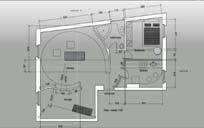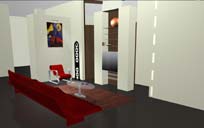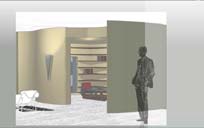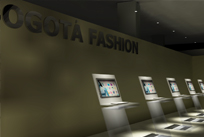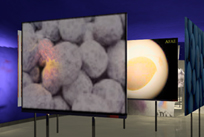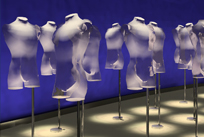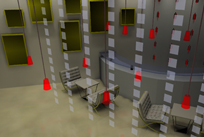INTERIOR AND INDUSTRIAL DESIGN COURSES
(click on titles to expand and get details)
HISTORY OF ARCHITECTURE
This fundamental course will guide students through the evolution of architectural styles and theories with a particular focus on the specific cultural, social, political and economic contexts of design and constructions. Building won’t be treated per se, but contextualized inside their respective framework of cultural beliefs and ideas, values and aesthetic ideals actualized through forms and functions. IIDHOA-110 | 45 hours | 3 credits
ITALIAN DESIGN MASTERS
Based on the more general courses of Design and Architecture History, this course focuses on the figure and works of the great Italian actors in architecture, automotive, industrial and object design. The works of these globally recognized designers will be analyzed in their historical, cultural and social context, allowing a deep understanding of the mechanics behind the choice of form, colors and materials. Students will be able to draw inspiration and vision from the work of designers like Battista “Pinin” Farina, Renzo Piano, Marco Piva, Claudio Bellini, Alberto Meda and other famous names of Italian Design. IIDIDM-120 | 45 hours | 3 credits
HISTORY OF DESIGN
This course will survey the history of Design from the mid-19th century to the present, contextualizing each designer and work inside the historical, social, cultural and artistic settings of the period. Students will understand the materials, techniques and crafts while analyzing the meaning of design works in their historical settings, while focusing on the relation between the designer and the object of design and understanding why each object of design looks the way it does. IIDHOD-130 | 45 hours | 3 credits
FASHION ARCHITECTURE AND DESIGN
The lines traced between the worlds of Fashion and Design/Architecture become more and more subtle, and today’s expression of style is often a mixture of their aspects, found in fashion environments like trend forum, fashion show, concept shops, fashion and design fairs. The aim of this course is to study and analyze the interaction and integration between these fields, allowing students to design spaces where a perfect balance between these three disciplines is a sum of their most peculiar aspects and translate in a meaningful environment which emphasizes the traits of the fashion message. IIDFAD-140 | 45 hours | 3 credits
GEOMETRICAL AND TECHNICAL DRAWING
The basics of every design career are found in a solid background in the techniques of geometrical and technical drawing, as they become a fundamental step before approaching the use of digital drawing tools. In this course students will learn the drawing of plain and solid geometrical shapes starting from orthographic projections, axonometry and perspective and completing the course with concepts like sectional views and intersection of solids that will be found later in 2D and 3D CAD courses. The course offers a particular focus on drawing techniques applied to design and architecture projects. IIDGTT-150 | 45 hours | 3 credits
INTERIOR DESIGN
In this course students will build a fundamental part of their professional career learning the basics of interior design. Analyzing the elements of each interiors and objects design project and mastering the combination of materials with colors, light and forms they will create spaces and objects able to meet and satisfy the demands of consumers and markets. The course uses both traditional and innovative materials and is based on different techniques of visualization including three-dimensional design, allowing students to personalize their projects. The study of contemporary design and methodology of Italian and international leaders in the field will offer them a much broader vision. IIDIND-160 | 45 hours | 3 credits
OBJECT DESIGN
This course guides students through the creation of objects in a perfect blend of technology, craft, design and art. Students will learn how to create objects while analyzing and understanding 3D fundamental elements like form, function, materials, value and social relevance. Through the investigation of digital and material 3D object creation in relation to discipline specific practices, students will understand contemporary technological processes such as rapid prototyping, computer controlled laser and milling machines, digital modeling and rendering. Students will also develop the ability to communicate concepts to industrial manufacturing professionals. IIDOBD-170 | 45 hours | 3 credits
LIGHTING
In this course students will learn about the technology of lighting and acquire the ability to understand lighting use and its effects in interior spaces. Through the analysis and application of technical and aesthetic principles, students will learn how to create a professional lighting project taking account of aspects like natural and environmentally friendly light sources and artificial lighting managed by electronic control systems. At the end of the course they will be able to design light installations for various environment and manage the distribution of natural and artificial light sources through the use of architectural and object design. IIDLGT-180 | 45 hours | 3 credits
TECHNOLOGY OF MATERIALS
The evolution of interior and object design isn’t influenced only by cultural, social and stylistic trends or by new industrial tools used in production. The arrival of new materials and their specific characteristics also changes the way designers work and fuels their creativity, influencing the design and development of buildings and everything else, like furniture, lighting and objects in general. This course introduces to the history of materials and their technology to focus on the trends influencing contemporary and future design techniques and styles. IIDTOM-190 | 45 hours | 3 credits
FURNITURE DESIGN
Starting with the historical aspects of Furniture Design, this course guides through the exploration of materials, tools and techniques while outlining the entire process from the initial design to development and production, including the use of prototypes. Italian and international furniture will be used in the examples and documentation to build a wide understanding of the different materials, styles and technologies upon which students will be able to create their professional unique skills in creativity and design. IIDFUD-200 | 45 hours | 3 credits
2D CAD FOR DESIGN
Two-dimensional design covers all aspects of the creation of simple and complex shapes in design projects, using all the fundamental elements like line, shape, form, texture, perspective and color. Through the use of 2D CAD software, students will learn how to work on various assignments with basic and advanced tools and using both raster and vector graphics, learning all the basic skills required in this area of design. IIDBDCD-210 | 45 hours | 3 credits
3D CAD FOR DESIGN
In this course students will learn how to design three-dimensional spaces and objects applying surface and lighting with the aid of 3D software tools. Through the use of modeling techniques, students will draw, observe and manipulate several models of increasing complexity, understanding the techniques used in the creation of objects, furniture and interior spaces. IIDTDCD-220 | 45 hours | 3 credits
RENDERING
Representing the natural follow-up to 3D CAD learning, this course aims to give students the skills needed in the rendering process, to produce a finished model with the combined use of simulated lighting sources over surfaces and textures of simulated materials. The aim of this course is to give each student a good knowledge and expertise of the rendering tools offered by professional software applications in the design area, together with the skills that allow the use of all representation techniques. Students will learn how to represent materials and apply the appropriate lighting, enhancing form and space. IIDRND-230 | 45 hours | 3 credits
FASHION CONCEPT SHOP DESIGN
Brand identity is reflected in the way shops and stores are presented to the public, thus future fashion professional must be able to create effective and strong concepts and apply them to a complete environment where customers are surrounded by wonder and excitement. Concept Store are distinguished by a high degree of specialization, thus the idea needs to be a perfect blend of top quality services and products in different areas building an experience of coherence and harmony in the customer. The environment architecture must emphasize the products perception: choice of lighting, music background, essences must involve customers’ senses and leave a pleasant memory of their experience. IIDFCSD-240 | 45 hours | 3 credits
TREND FORUM DESIGN
Fashion fairs, both textile, leather and garments, are a match point for all professionals in the industry. Inside these events exhibitors’ objectives in showing their collections the best way meet the buyers’ goal to find the collection that best suit their needs. Trend Forums must meet both these needs, thus the students’ aim is to acquire the strategies and mechanics of communication and presentation that best deliver the event ‘message’. IIDTFD-250 | 45 hours | 3 credits
FOOD AND DRINK CONCEPT DESIGN
Food and drinks are two important aspects of a country or region culture and tradition, thus becoming an effective ground in a concept design: understanding the way food and drinks relate to a particular lifestyle and culture (European, Asian, Italian, etc.) will help students in the search and definition of an effective framework where the products perception are emphasized by the choice of very element of the environment, including lighting, music background and essences, to involve customers’ senses and leave a pleasant memory of their experience. IIDFDCD-260 | 45 hours | 3 credits
FAIR AND EXHIBITION CONCEPT DESIGN
Fashion fairs textiles, leather and garments are a match point for all professionals in the industry. Inside these events exhibitors’ objectives in showing their collections the best way meet the buyers’ goal to find the collection that best suit their needs. A professional fair designer needs to sum up an information background which covers different specific areas like those of logistics and communications, and also be able to understand the needs and trends in other important events like trend forum workshops and fashion shows. This global information background, together with groundbreaking presentation techniques, is the main contents of this unique course. IIDFECD-270 | 45 hours | 3 credits
WORKSPACE CONCEPT DESIGN
This original course aims to give students the skills needed to apply the principle of interior and furniture design to work environments in order to meet the ergonomics and usability needs in workspaces while ensuring those of security and safety. The aim is to create a better workspace environment through the strategic design of spaces, lighting, furniture and objects, while preserving the elegance and quality of elements. Students will also learn how to apply these principles and strategies to different working environments. IIDWCD-280 | 45 hours | 3 credits
PRODUCT AND PACKAGING DESIGN
The process that leads to the design of a product and its packaging is described and taught through this fundamental course, allowing students to learn the visual and marketing principles behind the choice of logos, colors, shapes and package in industrial products. Students will analyze the works of famous Italian and international designers and discover the social, cultural and artistic elements that have shaped the history and evolution of product design and industrial design. Each student will be able to develop a project through the various steps, from hand sketches to technical drawing and, through the use of 2D and 3D tools and traditional collage and mockup techniques, create a realistic model of the initial idea. IIDPPD-290 | 45 hours | 3 credits
SUSTAINABLE DESIGN
The responsibility of today’s designers towards environmental issues has led to the definition of “sustainable design” concept, in which architectural, interiors and objects are designed according to the demands of social, economic and environmental sustainability. Among the objective of this course is the search for solutions in design that take into account renewable energy sources (sun, wind, geothermal, etc.) and the use of recycled materials. IIDSUD-300 | 45 hours | 3 credits
PRODUCT DEVELOPMENT AND DESIGN - CONCEPTS GENERATION AND TESTING (basic)
In business and engineering, new product development (NPD) is the complete process of bringing a new product to market. There are two parallel paths involved in the NPD process: one involves the idea generation, product design and detail engineering; the other involves market research and marketing analysis. In this course we will focus on the design activities to increment efficiency and efficacy in NPD through virtualization of the process and “early testing”. After a general review of the NPD process we will focus on prototyping techniques, both traditional and Additive Manufacturing (or RP) techniques and 3D laser scanning , as well as 3D CAD modeling advanced techniques used to reduce TTM (Time to Market) in NPD and to increment both NPD efficiency and efficacy, as the efficient use of this techniques in product design allow an early testing with stakeholders of the design concepts. The course will give future designers a basic knowledge on – NPD and TTM techniques, prototyping techniques, Additive Manufacturing techniques (RP) , 3D laser scanning techniques and 3D modelling techniques for prototypes manufacturing and Generative Alghoritms use in 3D modelling. 30 hours – lectures, case studies 15 hours – laboratories, prototyping, 3D modeling and use of 3D laser scanner and data acquisition. PDAD-310 | 45 hours | 3 credits
PRODUCT DEVELOPMENT - DESIGN 3D MODELLING, GENERATIVE ALGHORITMS (advanced)
3D modeling advanced techniques for interior and fashion design, will be explored the use of Generative Algorithms , such as Grasshopper , an open source Rhino plug-in, to generate new design “genotypes”. Generative design is a design method in which the output – image, sound, architectural models, animation – is generated by a set of rules or an Algorithm, normally by using a computer program. Most generative design is based on parametric modeling. It is a fast method of exploring design possibilities that is used in various design fields such as Art, Architecture, Communication Design, and Product Design. Typically, generative design has:a design schema, a means of creating variations,a means of selecting desirable outcomes. Some generative schemes use genetic algorithms to create variations. Some use just random numbers. Generative design has been inspired by natural design processes, whereby designs are developed as genetic variations through mutation and crossovers. Generative design is becoming more important, largely due to new programming environments (Processing, Vvvv, Quartz Composer, Open Frameworks) or scripting capabilities (Rhino (JavaScript engine), Scriptographer) that have made it relatively easy, even for designers with little programming experience, to implement their ideas. (basic knowledge of 3D modelling tecniques and 3D CAD is required) 25 hours – lectures, case studies 20 hours – laboratories, 3D Modeling with Generative Alghoritms PDGA-320 | 45 hours | 3 credits
PRODUCT DEVELOPMENT - 3D LASER SCANNING AND PROTOTYPING (advanced)
In fashion – jewels and objects design the starting point of the whole “concept generation pipeline” is often an existing object, such an handmade wax or chalk sculpture, a piece of wood, a stone, an ancient glass or a bronze statue. To implement this “first object” in the NPD pipeline we need to use a device capable to “virtualize” it in an industrial 3D CAD environment: a laser scanner. The purpose of a 3D scanning is usually to create a point cloud of geometric samples on the surface of a subject, to extrapolate the shape of the subject (a process called reconstruction). A 3D scanner, like a camera collects color information about surfaces, collects distance information about surfaces within its field of view. The “picture” produced by a 3D scanner describes the distance to a surface at each point in the picture. This allows the three dimensional position of each point in the picture to be identified. For most situations, a single scan will not produce a complete model of the subject. Multiple scans, even hundreds, from many different directions are usually required to obtain information about all sides of the subject. These scans have to be brought in a common reference system, a process that is usually called alignment or registration, and then merged to create a complete model. This whole process, going from the single range map to the whole model, is usually known as the 3D scanning pipeline. The reconstructed object can then be used in the NPD process to create new concepts or new products. The course will focus on : 3D scanning devices (laser scanner), acquisition techniques, merging and reconstruction techniques. 15 hours – lectures, case studies 15 hours – laboratories, use of 3D laser scanner and data acquisition 15 hours – laboratories, merging and reconstruction PDLSP-330 | 45 hours | 3 credits

